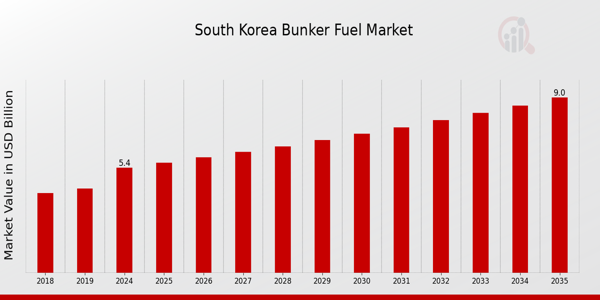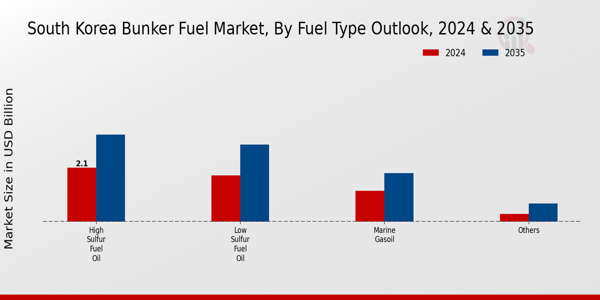South Korea Bunker Fuel Market Overview
The South Korea Bunker Fuel Market Size was estimated at 4.97 (USD Billion) in 2023. The South Korea Bunker Fuel Industry is expected to grow from 5.4(USD Billion) in 2024 to 9.0 (USD Billion) by 2035. The South Korea Bunker Fuel Market CAGR (growth rate) is expected to be around 4.753% during the forecast period (2025 - 2035).
Key South Korea Bunker Fuel Market Trends Highlighted
Numerous significant developments are being seen in the South Korean bunker fuel market, which are influenced by both domestic and foreign influences. Because of its advantageous location along important shipping routes, South Korea's shipping and maritime sector has grown. The need for bunker fuel is increased by this geographic advantage, especially since South Korea has emerged as a major East Asian maritime hub. The market for bunker fuel has also been affected by the recent move toward more ecologically friendly practices; South Korean shipping companies have invested in low-sulfur fuels as a result of the International Maritime Organization's regulations on the sulfur content of marine fuels, making compliance a key force behind change.
Amid these developments, there are abundant opportunities to be captured in the realm of alternative fuels. The South Korean government is actively promoting research and development in renewable energy sources such as LNG and hydrogen, aiming to support the maritime sector's transition to cleaner fuels. This presents a significant opportunity for bunker fuel providers to diversify their offerings and align with national policies aimed at reducing greenhouse gas emissions. In recent times, competitive pricing among suppliers has emerged as a key trend in the South Korean bunker fuel market, enabling shipping companies to optimize their fuel costs.Additionally, advancements in fuel management technology and services are enhancing efficiency and reducing wastage during bunkering operations. As the industry continues to evolve, South Korea's focus on sustainability, combined with its strong maritime infrastructure, will likely shape the future trajectory of the bunker fuel market in the region. Overall, these trends highlight a dynamic landscape that is adapting to both regulatory challenges and emerging opportunities in cleaner fuel technologies.

Source: Primary Research, Secondary Research, MRFR Database and Analyst Review
South Korea Bunker Fuel Market Drivers
Growing Maritime Trade in South Korea
The South Korea Bunker Fuel Market Industry is significantly driven by the increasing volume of maritime trade. According to the South Korean Ministry of Oceans and Fisheries, shipping and maritime activities contribute approximately 12% to the national GDP, highlighting how pivotal the sector is for the economy. The rise in cargo movements by sea has led to enhanced demand for bunker fuel, essential for the operation of ocean-going vessels. Furthermore, the Busan Port, which is one of the busiest ports in the world, saw container throughput reaching over 20 million TEUs, suggesting a robust increase in shipping activities.The strong growth in this sector not only fuels the bunker fuel demand but aligns with global trade patterns, solidifying South Korea's position as a maritime hub and enhancing growth prospects for the South Korea Bunker Fuel Market.
Regulatory Changes Promoting Cleaner Fuels
The South Korean government has been increasingly focused on environmental regulations aimed at reducing emissions from maritime vessels, thus stimulating the South Korea Bunker Fuel Market Industry. The introduction of stricter sulfur emissions limits by the International Maritime Organization (IMO) mandates that ship operators switch to low-sulfur fuel options. According to government announcements, by 2025, it is expected that the demand for marine fuel with reduced sulfur content will rise by over 30%.This regulatory change creates opportunities for suppliers of compliant bunker fuel, driving innovation and adapting production processes. Organizations such as the Korea Maritime Institute are also supporting this transition through research and technology development in cleaner fuel alternatives, thus fostering market growth.
Investment in Port Infrastructure
Investment in upgrading port infrastructure in South Korea is another driver of the South Korea Bunker Fuel Market Industry. The South Korean government plans to invest billions into improving facilities at major ports like Busan and Incheon. Established firms such as Korea Port Corporation are pivotal in these developments, which aim to enhance operational efficiency and cater to larger vessels capable of carrying increased cargo volumes. Improved port facilities facilitate quicker turnaround times for ships, fostering greater fuel consumption.As these ports expand, a corresponding increase in bunker fuel demand is anticipated to support the growing number of vessels calling at these upgraded ports, further boosting the South Korea Bunker Fuel Market.
South Korea Bunker Fuel Market Segment Insights:
Bunker Fuel Market Fuel Type Outlook Insights
The South Korea Bunker Fuel Market is evolving, driven by a focus on sustainability and regulatory changes, particularly in the Fuel Type Outlook segment. Bunker fuel is categorized into several types, including High Sulfur Fuel Oil, Low Sulfur Fuel Oil, Marine Gasoil, and others. High Sulfur Fuel Oil has been traditionally prominent in shipping due to its economic advantages; however, its usage is dwindling as stricter emissions regulations come into play, with the International Maritime Organization mandating lower sulfur emissions. In contrast, Low Sulfur Fuel Oil is gaining traction as vessels increasingly seek compliance with these regulations, emphasizing cleaner operations and increasing fuel efficiency.Among the alternatives, Marine Gasoil is regarded for its lower sulfur content and is often adopted by shipping operators keen on reducing their carbon footprint, providing a favorable balance between cost and environmental responsibility. Other fuel types, which might include biofuels and LNG options, signify a growing trend towards diversifying fuel sources driven by innovation and a push for environmental sustainability. The emphasis on these evolving fuel types reflects broader trends in the shipping industry toward cleaner fuels, driven by strict environmental regulations, and the quest for a greener future.The South Korea Bunker Fuel Market segmentation reveals significant shifts in consumer preferences and regulatory compliance, indicating a noteworthy transition within the industry. Overall, the Fuel Type Outlook segment stands as a crucial part of the South Korea Bunker Fuel Market, poised for growth, adaptation, and transformation as market dynamics and regulatory landscapes continuously evolve. The forward-looking insights indicate a nuanced and complex scenario where market participants must stay abreast of developments to remain competitive in the changing maritime fuel landscape.

Source: Primary Research, Secondary Research, MRFR Database and Analyst Review
Bunker Fuel Market Commercial Distributor Outlook Insights
The Commercial Distributor Outlook for the South Korea Bunker Fuel Market highlights a dynamic landscape characterized by the presence of Oil Majors, Large Independent Distributors, and Small Independent Distributors. Collectively, these entities play a critical role in ensuring the supply and distribution of bunker fuel, which is essential for the shipping and maritime industry in South Koreaa nation recognized for its substantial maritime shipping activities and prominent shipbuilding sector. Oil Majors often dominate this segment due to their extensive infrastructure and global procurement networks, which allow for consistent supply and reliability, crucial factors for international shipping lines operating in the region.Large Independent Distributors serve as a significant component of the market by catering to specific regional needs and offering flexibility in pricing and services, while Small Independent Distributors focus on niche markets, delivering specialized products and personalized service. The South Korea Bunker Fuel Market segmentation reflects varied operational strategies, driving competitive dynamics and influencing market trends such as sustainability initiatives and compliance with environmental regulations, which are becoming increasingly important in the global shipping industry.These aspects position the South Korea Bunker Fuel Market as an essential contributor to not just domestic energy needs, but also the broader international maritime supply chain.
Bunker Fuel Market Application Outlook Insights
The South Korea Bunker Fuel Market showcases a diverse Application Outlook, which is pivotal for its growth trajectory. Segmentation within this market includes Container, Bulk Carrier, Oil Tanker, General Cargo, Chemical Tanker, Fishing Vessels, Gas Tanker, and Others, each playing a significant role in the overall landscape. The Container segment is critical due to South Korea’s stature as a global shipping hub, facilitating international trade and major port activities. Meanwhile, Oil Tankers represent a vital channel for transporting crude oil and refined products, reflecting the region's reliance on energy imports.The Bulk Carrier sector significantly contributes to the shipping of raw materials essential for manufacturing industries in South Korea, while General Cargo ships meet diverse transport needs. Chemical Tankers and Gas Tankers are gaining prominence due to increasing chemical production and the necessity to transport liquefied gases safely. Fishing Vessels further underscore the marine industry’s contribution to the economy, supported by the nation's rich maritime resources. The South Korea Bunker Fuel Market revenue can be influenced by these segments' performance, highlighting their unique growth drivers and challenges, such as environmental regulations and fuel efficiency mandates, presenting opportunities for innovation within the industry.
South Korea Bunker Fuel Market Key Players and Competitive Insights
The South Korea Bunker Fuel Market is characterized by its strategic importance due to the country's thriving shipping and maritime industry. As a major player in global shipping routes, South Korea has a high demand for bunker fuels, making it a competitive landscape for various suppliers. The market is influenced by factors such as government regulations, environmental standards, and shifting demands due to the global energy transition. Companies striving for market share need to focus on innovative solutions and strategic partnerships to adapt to the evolving energy landscape. The competition in this market is intense, with global and regional players vying to meet the specific needs of shipping companies.Chevron has established a notable presence in the South Korea Bunker Fuel Market, leveraging its extensive global supply chain and operational expertise. The company's strength lies in its ability to deliver high-quality bunker fuels that meet stringent regulatory standards, which is crucial for mitigating environmental impact. Chevron's strong logistical network in South Korea enhances its capacity to provide reliable and timely supplies, catering to the needs of large shipping firms. Additionally, the company's investment in advanced technologies allows for efficient fuel management and customer service, further solidifying its competitive advantage within this market. The brand recognition and trust built over years in the industry contribute to Chevron's strong positioning in South Korea.Kuwait Petroleum Corporation has carved out a significant niche in the South Korea Bunker Fuel Market, focusing on providing premium-quality fuel products and services tailored to the maritime sector. The company offers a diverse range of bunker fuel options, including low sulfur fuels that comply with international regulations aimed at reducing emissions. Kuwait Petroleum Corporation benefits from a robust network of refineries and distribution channels, ensuring consistent supply and competitive pricing. In recent years, the corporation has strategically pursued mergers and partnerships to bolster its market presence in South Korea, enhancing its operational capabilities and service offerings. The company's commitment to sustainability and innovation has positioned it well in the South Korean market, allowing it to maintain a competitive edge amidst growing environmental concerns in the shipping industry.
Key Companies in the South Korea Bunker Fuel Market Include
- Chevron
- Kuwait Petroleum Corporation
- Shell
- TotalEnergies
- SOil
- MOL Group
- Phillips 66
- Lukoil
- SK Energy
- Hyundai Oilbank
- GS Caltex
- BP
- ExxonMobil
- Samsung Total Energy
South Korea Bunker Fuel Market Industry Developments
The South Korea Bunker Fuel Market is currently witnessing significant developments amid a backdrop of changing regulations and global demand shifts. In recent months, the market has been influenced by South Korea's commitment to reducing carbon emissions, prompting companies like SK Energy and GS Caltex to invest in cleaner fuel alternatives. Moreover, as of October 2023, Hyundai Oilbank announced expanding its low-sulfur fuel offerings, aligning with International Maritime Organization requirements.Mergers and acquisitions have also shaped the market, particularly the September 2023 acquisition of Samsung Total Energy’s marine fuel unit by MOL Group, which enhances MOL's position in the competitive bunker fuel arena. Growth in bunker fuel valuations has been notably robust, with market players like Chevron and BP actively adapting to fluctuating prices and regulatory pressures, thereby affecting supply chain dynamics.The past few years have seen increased bunker fuel prices and strategic collaborations among leading companies, including the 2021 partnership between Shell and TotalEnergies to enhance supply capabilities. With ongoing volatility influenced by geopolitical factors and ecological standards, the South Korean bunker fuel sector remains dynamic and closely monitored.
South Korea Bunker Fuel Market Segmentation Insights
Bunker Fuel Market Fuel Type Outlook
- High Sulfur Fuel Oil
- Low Sulfur Fuel Oil
- Marine Gasoil
- Others
Bunker Fuel Market Commercial Distributor Outlook
- Oil Majors
- Large Independent Distributor
- Small Independent Distributor
Bunker Fuel Market Application Outlook
- Container
- Bulk Carrier
- Oil Tanker
- General Cargo
- Chemical Tanker
- Fishing Vessels
- Gas Tanker
- Others
| Report Attribute/Metric Source: |
Details |
| MARKET SIZE 2018 |
4.97(USD Billion) |
| MARKET SIZE 2024 |
5.4(USD Billion) |
| MARKET SIZE 2035 |
9.0(USD Billion) |
| COMPOUND ANNUAL GROWTH RATE (CAGR) |
4.753% (2025 - 2035) |
| REPORT COVERAGE |
Revenue Forecast, Competitive Landscape, Growth Factors, and Trends |
| BASE YEAR |
2024 |
| MARKET FORECAST PERIOD |
2025 - 2035 |
| HISTORICAL DATA |
2019 - 2024 |
| MARKET FORECAST UNITS |
USD Billion |
| KEY COMPANIES PROFILED |
Chevron, Kuwait Petroleum Corporation, Shell, TotalEnergies, SOil, MOL Group, Phillips 66, Lukoil, SK Energy, Hyundai Oilbank, GS Caltex, BP, ExxonMobil, Samsung Total Energy |
| SEGMENTS COVERED |
Fuel Type Outlook, Commercial Distributor Outlook, Application Outlook |
| KEY MARKET OPPORTUNITIES |
Increasing shipping traffic demand, Transition to low-sulfur fuels, Expanding LNG bunker infrastructure, Growth in shipbuilding sector, Sustainability regulations driving innovation |
| KEY MARKET DYNAMICS |
Regulatory compliance requirements, Increasing vessel traffic, Environmental sustainability initiatives, Price volatility, Supply chain disruptions |
| COUNTRIES COVERED |
South Korea |
Frequently Asked Questions (FAQ) :
The South Korea Bunker Fuel Market is expected to be valued at 5.19 USD Billion in 2024.
By 2035, the South Korea Bunker Fuel Market is projected to grow to 8.24 USD Billion.
The expected CAGR for the South Korea Bunker Fuel Market from 2025 to 2035 is 4.3%.
The major fuel types include High Sulfur Fuel Oil, Low Sulfur Fuel Oil, Marine Gasoil, and Others.
In 2024, the market value of High Sulfur Fuel Oil is expected to be 1.56 USD Billion.
The projected market value for Low Sulfur Fuel Oil by 2035 is anticipated to be 2.75 USD Billion.
Key players in the South Korea Bunker Fuel Market include Korea Marine Transport, Total, SK Energy, and BP among others.
The estimated market size for Marine Gasoil in 2024 is 1.83 USD Billion.
Challenges that may impact the growth include environmental regulations and fluctuations in raw material costs.
The market is expected to evolve with increasing demand for low sulfur options and innovations in fuel technology.
By 2035, the South Korea Bunker Fuel Market is projected to reach a value of 9.0 billion USD.
The expected CAGR for the South Korea Bunker Fuel Market from 2025 to 2035 is 4.753%.
High Sulfur Fuel Oil is expected to dominate the market, valued at 2.1 billion USD in 2024.
The Low Sulfur Fuel Oil segment is valued at 1.8 billion USD in 2024.
The Marine Gasoil segment is expected to be valued at 1.2 billion USD in 2024.
The 'Others' segment is projected to be valued at 0.3 billion USD in 2024.
The market offers growth opportunities due to rising maritime trade and increasing fuel efficiency regulations.
The growth rate varies, with High Sulfur Fuel Oil and Low Sulfur Fuel Oil experiencing significant demand driven by regulatory changes.
















